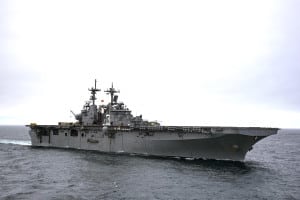The Marine Corps is already straining to meet crisis response requirements due to a lack of amphibious forces while the Navy and Marine Corps disagree on funding the future force.
Testifying before the Senate Armed Services Seapower subcommittee on April 26, Lt. Gen. Karsten Heckl, Deputy Commandant for Combat Development and Integration, said the Marine Corps being unable to sortie forces early to respond to Russia’s war with Ukraine is an example of how the current amphibious ship force is already limited before being impacted by budgetary changes that will lower the force.
Heckl said earlier this year U.S. European Command and NATO Supreme Allied Commander Europe commander Air Force Gen. Tod Wolters requested the 22nd Marine Expeditionary Unit [MEU] off the East Coast along with the Kearsarge Amphibious Ready Group “sortie early to be on station as the Ukrainian situation evolved, or devolved, and we were not able to sortie the ship[s].”
“The way we’ve typically conducted heel to toe deployments, the MEU should have been on station and available for the combatant commander tasking and it was not,” Heckl continued.
Heckl noted Marine Commandant Gen. David Berger’s “absolute requirement” for traditional, or L-class, amphibious warships is 31 vessels, divided into 10 LHA/LHD amphibious assault ships and 21 LPD amphibious transport dock ships.
“Within force design is our ongoing requirement as a Marine Corps and by law to be the crisis response force for the nation. Without those LPDs, sir, and other amphibious traditional L-class amphibious warships we cannot be there and we’re already struggling now,” Heckl said in response to questions from Ranking Member Kevin Cramer (R-N.D.).
While the amphibious ship force is currently at the Marine Corps requirement 31 amphibious ships, according to the long-range 30-year shipbuilding plan released by the Navy last week, it will drop to 24 ships by fiscal year 2024.

The Navy is currently planning to end the HII [HII]-built San Antonio-class Flight II LPD-17 ships with LPD-32, with a contract award expected in June 2023. However, the Marine Corps’ top listed unfunded requirement in FY ‘23 is $250 million in advanced procurement funds for LPD-33 (Defense Daily, April 1).
The Navy previously decided on replacing the 12 aging Whidbey Island/Harpers Ferry (LSD-41/49) class ships with the LPD-17 Flight II ships, which have an expected service life of 40 years.
However, in addition to ending LPD-17 Flight II ships at LPD-32, the long term shipbuilding plan says the Navy plans to retire 10 LSDs ranging from three to 14 years early. In FY ‘23 alone, the Navy is planning to retire and dismantle USS Germantown (LSD-42), Gunston Hall (LSD-44), Tortuga (LSD-46) and Ashland (LSD-48) in order to save money.
The shipbuilding plan argues “these legacy ships are in poor material condition due to their age and require significant resources to continue to maintain and operate. Shifting resources to other capabilities better supports the amphibious fleet, and provides more operational capability to the Navy and Marine Corps.”
Last week, Jay Stefany, Performing the Duties of Assistant Secretary of the Navy for Research, Development and Acquisition, told reporters that buying LPD-32 buys time for the Navy and Defense Department to finish going through the Force Structure Assessment and Secretary of the Navy-directed amphibious force ship study to both inform the FY ‘24 or ‘25 budget process (Defense Daily, April 22).
Stefany added that if whatever comes after LPD-32 is needed, under the current shipbuilding timelines, it would not need to be procured until FY ‘25.
“We may ultimately decide to do a modification, you know Block III if you will, or Flight III for LPD, we don’t know. But I think the idea was we would start the process in ‘22. When the actual ship might show up is pending the process happening,” Stefany said.
Cramer asked Heckl how important continuing the San Antonio-class LPDs is to the Marine Corps requirements for 31 amphibious vessels.
“It’s critical sir, to meet that requirement,” Heckl said.
Earlier in April, leaders of the House Armed Services Committee (HASC) Seapower subcommittee both said they support the Marine Corps’ request of LPD-33 advance procurement funding and believe it will ultimately be in the FY ‘23 defense budget (Defense Daily, April 5).
Stefany told the subcommittee the amphibious ship study is just completing now and still in the briefing process. He said it will be ready in the very near term and will then feed into the Force Structure Assessment and National Defense Strategy.
“So we’ll do that and that will ultimately get us to what is the final number of amphibious ships, traditional amphibious ships we’re talking about. And if it’s whatever it is….and we will then resource, given a constrained budget, to at some point get to that number,” he continued.
Stefany noted the Marine Commandant, Chief of Naval Operations, and Secretary of the Navy are scheduled to see the Senate Armed Services Committee in May “and the plan is to give you the results or at least talk about it, all three of them together. Then obviously it would have to go to [the Office of the Secretary of Defense] and then go through the other steps.”
The shipbuilding plan presents three options that split after FY ‘27 at the end of the current five year Future Year Development Program (FYDP), two that do not assume any major increase in Navy shipbuilding funding over recent historical levels and a third that includes a $75 billion increase in real growth starting in FY ‘28 in constant FY ‘22 dollars.
Under the first and third plan the Navy would get back to 31 amphibious ships by FY 2030 and the other plan would reach 31 ships in FY ‘31. Thereafter, all the plans would keep the amphibious ship count well above the 31-ship requirement through 2052. By then, the amphibious ship force would be at 44, 42, or 58 ships under each option, respectively.